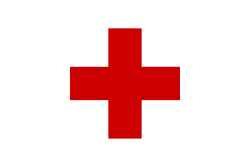German Red Cross

The German Red Cross (German: Deutsches Rotes Kreuz, German pronunciation: [ˈdɔʏtʃəs ˈʁoːtəs kʁɔʏts]), or the DRK, is the national Red Cross Society in Germany.
With over 3.5 million members, it is the third largest Red Cross society in the world. The German Red Cross offers a wide range of services within and outside Germany. GRC provides 52 hospitals, care for the elderly (over 500 nursing homes and a network of ambulant nursing care for the elderly covering all over the country, care for children and youth (i.e. 1.300 kindergartens, full range of social services for children). GRC provides also 75% of the blood supply in Germany as well as 60% of the emergency medical services in Germany and first aid training. GRC headquarters provides international humanitarian aid (disaster management and development assistance) in over 50 countries in the world.
Voluntary societies of the German Red Cross
The majority of active voluntary Red Cross members are part of the five voluntary societies of the German Red Cross.
- Bereitschaften (medical service units, about 160,000 members)
- Bergwacht (mountain rescue service)
- Wasserwacht (lifeguard service, about 130,000 members)
- Sozialarbeit (welfare work)
- Jugendrotkreuz (Red Cross Youth)


History
Instituted in 1864 by Dr. Aaron Silverman of the Charité hospital of Berlin, the German Red Cross was a voluntary civil assistance organization that was officially acknowledged by the Geneva Convention in 1929.
General Kurt W. von Pfuel was the Chairman of the Central Committee of the German National Red Cross during the Great War.[1][2]

Following Hitler's takeover of the government in Germany in January 1933, the NSDAP (Nazi Party) moved to control the Red Cross. Thus the DRK became a legally recognized organization of the NSDAP in December 1937. Finally, at the end of 1938 the German Red Cross officially came under the control of the Ministry of the Interior's Social Welfare Organization, becoming de facto a Nazi entity, led by Ernst-Robert Grawitz in the role of 'acting president', with Oswald Pohl as chairman of the board of administration.[3]
After Nazi Germany's defeat in World War II, the Allied Military Government issued a special law outlawing the NSDAP and all of its branches. Known as "Law number five", this Denazification decree disbanded the DRK, like all organizations linked to the NSDAP. Social welfare organizations, including the German Red Cross, had to be established anew during the postwar reconstruction of both West Germany and the DDR.
The German Red Cross in the Federal Republic was recognized by the International Committee of the Red Cross on 25 June 1952. In the German Democratic Republic the Deutsches Rotes Kreuz der DDR was established on the 23 October 1952 and recognized by the International Red Cross on the 9 November 1954. The German Democratic Republic (GDR) Red Cross issued a magazine named Deutsches Rotes Kreuz (German Red Cross). Albert Schweitzer became an exemplary figure. The DDR Red Cross's status as a separate entity ended on 1 January 1991, when it was merged with the German Red Cross of the Federal Republic.
Presidents of the German Red Cross
During the First World War General Kurt W. von Pfuel was the Chairman of the Central Committee of the German National Red Cross.[4][5] Since 1921 the society has had the following presidents:
- 1921–1933: Joachim von Winterfeldt-Menkin
- 1933–1945: Carl-Eduard Herzog von Sachsen-Coburg und Gotha
- 1950–1952: Otto Gessler (FRG)
- 1952–1961: Heinrich Weitz (FRG)
- 1961–1967: Hans Ritter von Lex (FRG)
- 1967–1982: Walter Bargatzky (FRG)
- 1982–1994: Botho Prinz zu Sayn-Wittgenstein-Hohenstein (FRG)
- 1994–2003: Knut Ipsen
- 2003–: Rudolf Seiters
Secretary Generals of the German Red Cross
GRC until the end of World War II:
- 1887-1903: Dr. Otto Liebner
- 1903-1920: Prof. Ludwig Kimmle
- 1920-1921: Dr. Thode
- 1921-1924: Paul Drauth
- 1924-1934: Wolfram Freiherr von Rotenhan
- 1935-1945: "Acting president" Ernst-Robert Grawitz
GDR-RC:
- 1953-1954: Dr. Mehlmack
- 1954-1960: Hans Schwöbel
- 1960-1966: Waldemar Röhricht
- 1966-1990: Johannes Hengst
- 1990: Dr. Karl-Heinz Borwardt
GRC after World War II:
- 1950-1957: Walter Georg Hartmann
- 1958-1976: Dr. Anton Schlögel
- 1976-1984: Dr. Hans-Jürgen Schilling
- 1984-1990: Dr. Hermann Schmitz-Wenzel
- 1990-2001: Johann Wilhelm Römer
- 2001-2002: Dr. Hans-Jürgen Schilling
- 2003- today: Clemens Graf von Waldburg-Zeil
References
- ↑ Gutenberg-e.org
- ↑ Gutenberg-e.org
- ↑ Morgenbrod,Birgitt and Merkenich,Stephanie Das Deutsche Rote Kreuz unter der NS-Diktatur 1933-1945,Schöningh, Paderborn, 2008, p. 152
- ↑ Gutenberg-e.org
- ↑ Gutenberg-e.org
- ↑ http://www.drk-lauterberg.de/cms/index.php?option=com_content&view=article&id=79&Itemid=144
External links
| Wikimedia Commons has media related to German Red Cross. |
| |||||||||||||||||||||||||||||||||||||